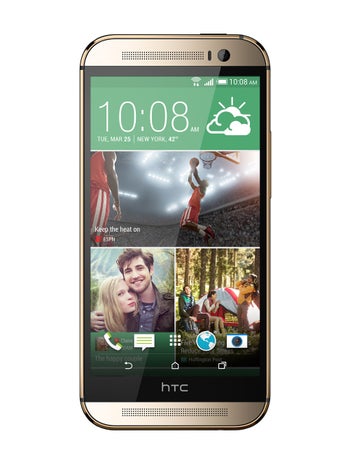HTC Desire Eye vs HTC One M8 vs Samsung Galaxy S5: specs comparison

Now that the HTC Desire Eye's official existence is no longer a poorly-hidden industry secret, it's time we see how this camera-intensive smartphone compares to some of our favorite specs monsters from the first half of 2014. How about we put it against the HTC One M8 and Samsung Galaxy S5? The former is his twin brother, the latter is still one of the best Android phones around.
First things first, the Desire Eye sticks out as the largest of the three. It's taller and wider than both the One (M8) and the Galaxy S5, it's still thinner than the M8, and it's 0.32 oz (9 g) heavier than both. It seems that 13MP front camera really took its toll.
The HTC Desire Eye also has the largest 1080p display in the trio - it's a 5.2-inch screen, while the One (M8) has a 5.0-inch screen, and the Galaxy S5 sports a 5.1-incher of a panel. At 441ppi, the One M8 has the highest pixel density, followed by the Galaxy S5 (432ppi) and the Desire Eye (423ppi).
Camera-wise, the HTC Desire Eye trumps both the Galaxy S5's measly 2.1-megapixel front cam, and the HTC One (M8)'s decent 5-megapixel front snapper with a full-blown 13MP camera on the front panel. Yikes! Samsung's flagship still has the biggest rear camera sensor (16MP) to play with, followed by the Desire Eye's 13MP main cam, while the HTC One (M8) differentiates with its quirky 4-ultrapixel Duo camera setup.
In terms of hardware, the trio is almost exactly on par. All three smartphones run on the Qualcomm Snapdragon 801 chipset, sporting minute differences in clock rates that favor the Galaxy S5's 2.5GHz over the HTC Desire Eye and One (M8)'s 2.3GHz. All have Adreno 330 GPUs and 2GB of RAM on disposal. Each device's in-built storage can be expanded with a microSD card.
Finally, both the HTC Desire Eye and One (M8) have 2600mAh battery to get them through the day, while the Samsung Galaxy S5 has a slightly bigger 2800mAh unit.
So, which one is the best-specc'd phone according to you?
Camera-wise, the HTC Desire Eye trumps both the Galaxy S5's measly 2.1-megapixel front cam, and the HTC One (M8)'s decent 5-megapixel front snapper with a full-blown 13MP camera on the front panel. Yikes! Samsung's flagship still has the biggest rear camera sensor (16MP) to play with, followed by the Desire Eye's 13MP main cam, while the HTC One (M8) differentiates with its quirky 4-ultrapixel Duo camera setup.
Finally, both the HTC Desire Eye and One (M8) have 2600mAh battery to get them through the day, while the Samsung Galaxy S5 has a slightly bigger 2800mAh unit.
So, which one is the best-specc'd phone according to you?
|
|
|
|
| HTC Desire EYE | HTC One (M8) | Samsung Galaxy S5 |
| Dimensions | ||
|---|---|---|
| 5.97 x 2.91 x 0.33 inches 151.7 x 73.8 x 8.5 |
5.76 x 2.78 x 0.37 inches 146.36 x 70.6 x 9.35 mm |
5.59 x 2.85 x 0.32 inches 142 x 72.5 x 8.1 mm |
| Weight | ||
| 5.43 oz / 154.0 g | 5.64 oz / 160.0 g | 5.11 oz / 145.0 g |
| Materials | ||
| Back: Aluminum | Back: Plastic | |
| Resistance | ||
| Water; Yes | Splash; IPX3 | Water, Dust; IP67 |
| Biometrics | ||
| Fingerprint (swipe) | ||
| Features | ||
| Notification light | Touch sensitive control keys, Interchangeable covers, Notification light | |
| Keys | ||
| Right: Volume control, Camera shutter, Lock/Unlock key | Right: Volume control | Left: Volume control; Right: Lock/Unlock key |
| Colors | ||
| Gold, Gray, Silver, Pink, Blue, Red | Black, Gold, Blue, White | |
| Size | ||
|---|---|---|
| 5.2-inch, 66.51% screen-to-body | 5.0-inch, 66.71% screen-to-body | 5.1-inch, 69.76% screen-to-body |
| Type | ||
| S-LCD 3 | Super AMOLED | |
| Resolution | ||
| 1920x1080px, 424 PPI | 1920x1080px, 441 PPI | 1920x1080px, 432 PPI |
| Colors | ||
| 16 777 216 | ||
| Protection | ||
| Corning Gorilla Glass 3 | ||
| System chip | ||
|---|---|---|
| Snapdragon 801 | Snapdragon 801 | Snapdragon 801 MSM8974-AC (28 nm) |
| Processor | ||
| Quad-core 2300 MHz | Quad-core 2300 MHz Krait 400 | Quad-core 2500 MHz Krait 400 |
| GPU | ||
| Yes | Adreno 330 | Adreno 330 |
| Memory | ||
| 2GB/16GB | 2GB (LPDDR3)/32GB 2GB/16GB | 2GB (LPDDR3)/32GB 2GB/16GB |
| Storage expansion | ||
| microSDXC up to 128 GB | microSDXC up to 128 GB | microSDXC up to 128 GB |
| OS | ||
| Android (5.0 Lollipop, 4.4.4) | Android (6.0 Marshmallow, 5.0 Lollipop, 4.4.3, 4.4) | Android (6.0 Marshmallow, 5.1 Lollipop, 5.0 Lollipop, 4.4.4, 4.4.2) |
| Type | ||
|---|---|---|
| 2400 mAh, Li - Polymer | 2600 mAh, Li - Polymer | 2800 mAh, Li - Ion |
| Charging | ||
| Qualcomm Quick Charge 2.0 | Qualcomm Quick Charge 2.0 | |
| Rear | ||
|---|---|---|
| Single camera | Dual camera | Single camera |
| Main camera | ||
| 13 MP (Autofocus, BSI sensor) Aperture size: F2.0 Focal length: 28 mm | 4 MP (Autofocus) Aperture size: F2.0 Focal length: 28 mm Sensor size: 1/3" Pixel size: 2 μm |
16 MP (BSI sensor, PDAF) Aperture size: F2.2 Focal length: 31 mm Sensor size: 1/2.6" Pixel size: 1.12 μm |
| Second camera | ||
| 4 MP (Depth information) | ||
| Flash | ||
| Dual LED | Dual LED | LED |
| Video recording | ||
| 1080p Video calling | 1080p (60 fps), 720p (120 fps) HDR, Video light, Video sharing | 4K UHD (30 fps), 1080p (60 fps) HDR, Continuous autofocus, EIS, Video calling, Video sharing |
| Front | ||
| 13 MP (Autofocus, Flash, HDR) Video capture: 1080p | 5 MP Video capture: 1080p | 2.1 MP Video capture: 1080p |
| Bluetooth | ||
|---|---|---|
| 4.0 | 4.0 | 4.0 |
| WLAN | ||
| a,b,g,n,dual-band 802.11 a, b, g, n | a,b,g,n,ac,dual-band 802.11 a, b, g, n, ac | a,b,g,n,ac,dual-band Multiple antennas, MIMO, Hotspot, Wi-Fi Direct 802.11 a, b, g, n, ac |
| USB | ||
| microUSB, USB 2.0 | microUSB, USB 2.0 | microUSB, USB 3.0 |
| Sensors | ||
| Accelerometer, Gyroscope, Compass, Ambient light sensor, Proximity sensor | Accelerometer, Gyroscope, Compass, Barometer, Ambient light sensor, Proximity sensor | Accelerometer, Gyroscope, Pedometer, Compass, Hall (for flip covers), Gesture, Barometer, Step detector, Step counter, Ambient light sensor, Proximity sensor |
| HDMI | ||
| Yes | Yes | |
| Location | ||
| GPS, A-GPS, Glonass | GPS, Glonass | GPS, A-GPS, Glonass |
| Other | ||
| NFC, Tethering, Computer sync, OTA sync | NFC, Infrared, Tethering, Computer sync, OTA sync | NFC, ANT+, Infrared, Tethering, Computer sync, OTA sync |
| Headphones | ||
|---|---|---|
| 3.5mm jack | 3.5mm jack | 3.5mm jack |
| Speakers | ||
| Earpiece, Multiple speakers | Earpiece, Multiple speakers | Earpiece, Loudspeaker |
| Features | ||
| Album art cover, Background playback | Album art cover, Background playback | Album art cover, Background playback |
| Screen mirroring | ||
| DLNA,Wireless screen share | DLNA,Wireless screen share,MHL,MirrorLink | MHL |
| Radio | ||
| FM, Stereo, RDS | ||
| Additional microphone(s) | ||
| Noise cancellation | Noise cancellation, Video recording | |
| LTE Bands | ||
|---|---|---|
| 3, 7, 8, 20 | 3, 7, 8, 20 | 1, 2, 3, 5, 7, 8, 20 |
| 3G Bands | ||
| 5, 8, 1 | 5, 8, 2, 1 | |
| Data Speed | ||
| HSDPA+ (4G) 42.2 Mbit/s | LTE, HSDPA+ (4G) 42.2 Mbit/s | LTE Cat 4 (150/50 Mbit/s), HSDPA+ (4G) 42.2 Mbit/s, HSUPA 5.76 Mbit/s, UMTS |
| SIM type | ||
| Nano SIM | Nano SIM | Micro SIM |
| VoLTE | ||
| Yes | Yes | |
| Notifications | ||
|---|---|---|
| Haptic feedback, Music ringtones (MP3), Polyphonic ringtones, Vibration, Flight mode, Silent mode, Speakerphone | ||
| Other features | ||
| Voice dialing, Voice commands, Voice recording | ||
| FCC approval | ||
|---|---|---|
| Date approved: Oct 10, 2014 FCC ID value: NM80PFH100 | FCC ID value: NM80P6B100 | |
| Measured SAR | ||
| Head: 0.61 W/kg Body: 0.91 W/kg Simultaneous Transmission: 1.21 W/kg Wireless Router: 0.91 W/kg |
||
| Officially announced | ||
|---|---|---|
| Oct 08, 2014 | Mar 25, 2014 | Feb 24, 2014 |
See the full
HTC Desire EYE vs HTC One (M8) vs Samsung Galaxy S5 specs comparison
or compare them to other phones using our
Phone Comparison tool
Follow us on Google News












![A new Android bug is making it impossible to install new apps. Are you affected? [UPDATE]](https://m-cdn.phonearena.com/images/article/176703-wide-two_350/A-new-Android-bug-is-making-it-impossible-to-install-new-apps.-Are-you-affected-UPDATE.webp)

Things that are NOT allowed:
To help keep our community safe and free from spam, we apply temporary limits to newly created accounts: